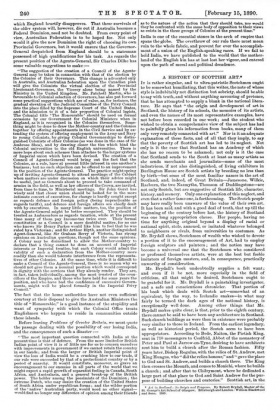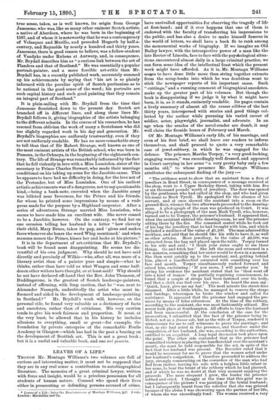A HISTORY OF SCOTTISH ART.*
IT is rather singular, and to ultra-patriotic Scotchmen ought to be somewhat humiliating, that this writer, the note of whose style is indubitably not distinction but sobriety, should be able to say with truth, and without anything savouring of pretence, that he has attempted to supply a blank in the national litera- ture. He says that "the origin and development of art in Scotland, the history of its schools, the memoirs of its artists, and even the names of its most representative examples, have not before been recorded in one work; and the student who wished to obtain a comprehensive view of the subject has had to painfully glean his information from books, many of them only very remotely connected with art." Nor is it an adequate explanation of these facts, and of all that they imply, to say that the poverty of Scottish art has led to its neglect. Not only is it the case that Scotland has an Academy of which she has no reason to be ashamed ; not only is it the case that Scotland sends to the South at least as many artists as she sends merchants and journalists—some of the most industrious, if not also distinguished, of living exhibitors in Burlington House are Scotch artists by breeding no less than by birth—but some of the most familiar names in the art of Scotland, and, indeed, of Great Britain—Jamesone, Wilkie, Raeburn, the two Nasmyths, Thomson of Duddingstone—are not only Scotch, but are suggestive of Scottish life, character, history, and scenery. Only one explanation of this neglect, and even that a rather lame one, is forthcoming. The Scotch people may have really been -unaware of the value of their own art. It has been said, and with a good deal of truth, that up till the beginning of the century before last, the history of Scotland was one long appropriation clause. Her people, having no time for anything original beyond a display of racial or national spirit, stole, annexed, or imitated whatever belonged to neighbours or rivals, from universities to costumes. As Mr. Brydall shows, Scotchmen of wealth who wished to devote a portion of it to the encouragement of Art, had to employ foreign sculptors and painters ; and the notion may have become a universal one that the Scotchmen who considered or professed themselves artists, were at the best but feeble imitators of foreign masters, and, in consequence, practically unworthy of consideration.
Mr. Brydall's book undoubtedly supplies a felt want ; and even if it be not, more especially in the field of criticism, all that might be desired, Scotchmen ought to be grateful for it. Mr. Brydall is a painstaking investigator, and a safe and conscientious chronicler. That portion of his book which deals with Scotch art—somewhat of an equivalent, by the way, to Icelandic snakes—in what may fairly be termed the dark ages of the national history, is exceptionally well done. Among other things that Mr. Brydall makes quite clear, is that, prior to the eighth century, there cannot be said to have been any architecture in Scotland. Such church buildings as were then in existence were probably very similar to those in Ireland. From the earliest legendary, as well as historical period, the Scotch seem to have been appropriators. According to Bede, Naiton, the Pictish King, sent in 710 messengers to Ceolfrid, Abbot of the monastery of Peter and Paul at Jarrow-on-Tyne, desiring to have architects sent him to build a church after the Roman fashion. Fifty years later, Bishop Regulus, with the relics of St. Andrew, met King Hungus, who " did the relics honour," and" gave the place to God and St. Andrew, and builds a church there. The King then crosses the Mounth, and comes to Monichi, where he builds a church ; and after that to Chilrymont, where he dedicated a large part of that place to God and Saint Andrew for the pur- pose of building churches and oratories." Scottish art, in the
• Art in Scotland : its Origin and Progress. By Robert Brydall, Master of the St. George's Art School of Glasgow. Edinburgh and London: William Blackwood and Sons. 1889.
true sense, takes, as is well known, its origin from George Jamesone, who was, like so many other eminent Scotch artists, a native of Aberdeen, where he was born in the beginning of 1587, and of whom it is noteworthy that he was a contemporary of Velasquez and Murillo, and preceded Hogarth by half-a- century, and Reynolds by nearly a hundred and thirty years. Jamesone, there is good reason to believe, was a fellow-student of Vandyke under Rubens at Antwerp, and, in consequence, Mr. Brydall describes him as "a curious link between the art of Flanders and that of Scotland." He was essentially a popular portrait-painter, and a more forcible art-critic than Mr. Brydall has, in a recently published work, accurately summed up his achievements by saying that "his art is so plainly informed with the peculiar spirit of Scotch puritanism as to be national in the good sense of the word ; his portraits are such capital history and such good painting that they remain an integral part of Scotland."
It is plain-sailing with Mr. Brydall from the time that Jamesone flourished down to the present day. Scotch art branched off in different lines, and along these lines Mr. Brydall follows it, giving biographies of the artists belonging to the different schools. In the course of his researches, he has rescued from oblivion the work of many a Scotchman who did too slightly regarded work in his day and generation. Mr. Brydall's biographies are uniformly trustworthy, even if they are not uniformly readable. He has no more remarkable story to tell than that of Sir Robert Strange, well known as one of the most eminent artists of the British school, who was born in Pomona, in the Orkneys, in the beginning of the eighteenth cen- tury. The life of Strange was remarkably influenced by the fact that he fell violently in love with a Miss Lumisden, sister of the secretary to Prince Charles Stewart, who made their marriage conditional on his taking up arms for the Jacobite cause. This he appears to have had no difficulty in doing, for the love not of the Pretender, but of Miss Lumisden. One of his earliest artistic achievements was of a dangerous, not to say questionable kind,—being a bank-note, executed when the Jacobite army was billeted near Inverness, for the Prince and his friends, for whom he printed some impressions by means of a rude press made for the purpose by a Highland carpenter. After a series of adventures, Strange married Miss Lumisden, who seems to have made him an excellent wife. She never ceased to be a Jacobite, however. On the contrary, we find her on one occasion telling her husband in a letter "how cleverly their child, Mary Bruce, takes its pap, and girns and makes faces whenever she hears the word Whig mentioned,' and when mamma names the Prince, kisses her and looks at his picture."
It is in the department of art-criticism that Mr. Brydall's book will be found most disappointing. He seems too dis- trustful of his own judgment. Why should he not have said -directly and precisely of Wilkie—who, after all, was more of a literary artist than of a painter pure and simple—what he thinks, rather than have told us what Waagen and some half. dozenother writers have thought, or at least said ? Why should he not have declared off-hand that the Rev. John Thomson, of Daddingstone, is the greatest of Scotch landscape-painters, instead of affirming, with limp caution, that he "was, next to Alexander Nasmyth, undoubtedly the artist who most in- fluenced and aided in the development of landscape-painting in Scotland ?" Mr. Brydall's work will, however, on the personal side, be found very valuable as a dictionary of facts and anecdotes, rather than of criticisms. His very caution tends to give his work fairness and proportion. It must, at the very least, be allowed that in his history he includes allusions to everything, small or great—for example, the foundation by private enterprise of the remarkable Foulis Academy in Glasgow—which has had in the past a bearing on the development of Scottish art. This is not a great book ; but it is a useful and valuable book, and one sui generis.



































 Previous page
Previous page